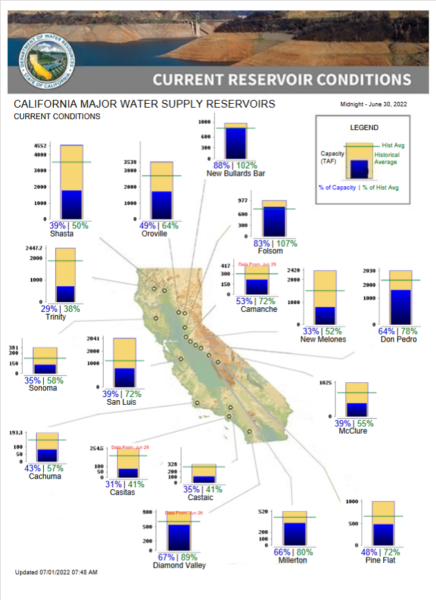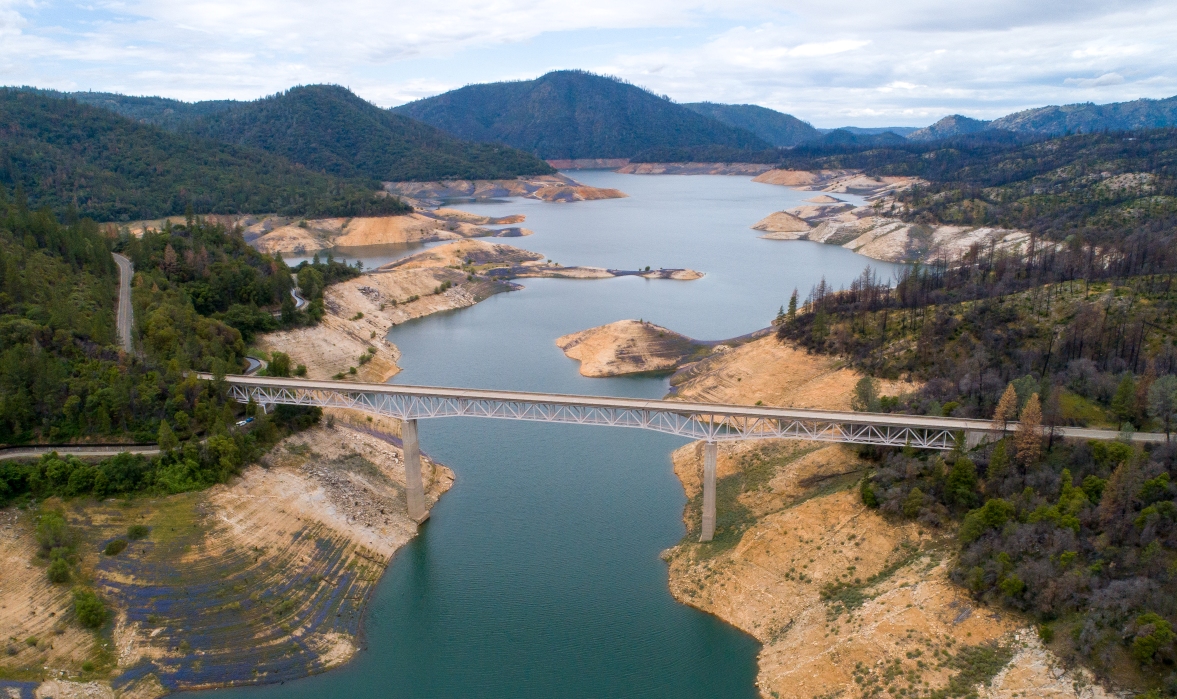 Written exclusively for Maven’s Notebook by Robert Shibatani
Written exclusively for Maven’s Notebook by Robert Shibatani
As we enter summer’s anvil, where are we reservoir storage wise?
Relative to other years we have been fortunate in one sense since the excruciating heat waves that we have become all too familiar with have not emerged (… at least not yet). In fact, sporadic early summer storms have even provided some respite.
Nevertheless, the ET/P↓ ratios are steepening. Shasta, Folsom, and New Melones reservoirs received 1.05, 0.4, and 0.08 inches of precipitation, respectively, in June. Corresponding calculated direct water loss through evaporation, however, were 9.17, 8.32, and 10.21 inches, respectively. These are not insignificant quantities as they translate into some 5,700 AF of direct evaporative loss for Folsom, 8,500 AF for Shasta Reservoir, 4,100 AF for New Melones, 9,700 AF for San Luis, and some 3,100 AF for Millerton.
Interestingly, accumulated WY precipitation to date at major reservoir locations are not as bad as some would like us to think. For example, total WY accumulated precipitation-to-date in the upper American River basin at Blue Canyon is still 99% of average, the Stanislaus River at New Melones is at 72%, Shasta Dam 69%, and the Trinity River fish hatchery 62%. The point being none of the CVP monitored locations is below 50% for the WY, a metric that is typically associated with catastrophic drought. Even the notoriously dry southern San Joaquin valley at Huntington Lake is at 61%.
Currently, total CVP reservoir storage as of June 28 stood at 4.720 million acre-feet (MAF). We lost about 284,000 AF over the month of June, not bad, all things considered. San Luis Reservoir lost the largest volume (e.g., 116,000 AF) in June, followed by New Melones (e.g., 73,000 AF), Folsom (e.g., 42,000 AF), and Shasta (e.g., 36,000 AF).
Reservoir releases have been fairly consistent over the month. Typically, during June, delta inflow relies on a large portion of freshwater supply from the upper Sacramento River, notably from releases at Shasta and Keswick. The release history has had the upper Sacramento providing about 10,000-11,000 cfs, the Feather River from Oroville Reservoir about 1,800-3,000 cfs, and the American River from Folsom Reservoir some 2,000-3,800 cfs as a daily flow during June. For this WY, however, the big difference has been the notable shortfall in upper Sacramento River releases. Upper Sacramento River flows have been consistently 4,000-7,000 cfs shy of the long-term average for June. What this has meant is that Oroville Reservoir has had to exceed its daily releases, relative to its long-term averages and, as we near the end of June, Folsom Reservoir has taken on a significantly larger responsibility. As of yesterday (e.g., June 28), Folsom Reservoir was releasing near 5,000 cfs (above its approximate 3,800 cfs daily historic average).
With storages at Folsom Reservoir running above 820,000 AF (representing 113% of average), this is where having a surplus of this magnitude available in such close proximity to the delta is notably helping this year’s water operations. In fact, we can expect Folsom Reservoir to play a dominant role in meeting in-delta water quality and flow objectives in July. In the delta, total inflows averaged about 9,760 cfs for the month. The 7-day outflow is about 5,000 cfs less, at 4,771 cfs on a daily average. Exports have been held steady around 1,300 cfs.
The California snowpack as of mid-June was effectively gone.
Prepared by Robert Shibatani
Robert Shibatani, a physical hydrologist with over 35-years combined experience as an international expert witness on reservoir-operations, climate change hydrology, commercial flood damage litigation, and water supply development. He is Managing Partner for The SHIBATANI GROUP International, a division of The SHIBATANI GROUP Inc. and resides in Sacramento, California. robert@theshibatanigroup.com
FOR MORE INFORMATION
Reservoirs
- Daily Reservoir Summary
- Selected Reservoirs, Daily Graphs (interactive)
- CA Data Exchange Center: Reservoirs
- CVP Daily Water Supply Report
Precipitation
- Real-time Rainfall Maps
- Detailed Monthly Precipitation Summary for Water Year
- Center for Western Weather and Water Extremes (CW3E)
Snow
Full Natural Flow Data
Drought/Climate
Water Project Operations
- State Water Project Operations and Delta Status
- Central Valley Project Operations
- Lower Colorado River Operations
Delta conditions
- Bay-Delta Live (Real Time Delta Conditions)
- EcoAtlas (Delta Restoration Projects)
Specialty Portals
- My Water Quality (CA Water Quality Monitoring Council)
- Fish Surveys (Department of Fish and Wildlife)
- NASA GRACE Groundwater and Soil Moisture Conditions


